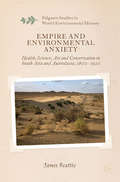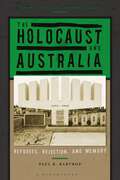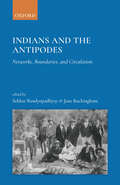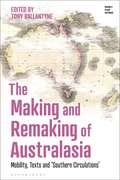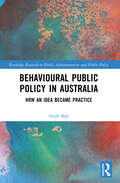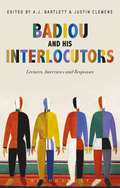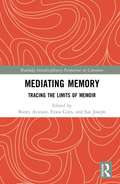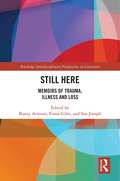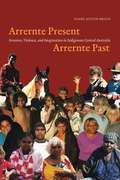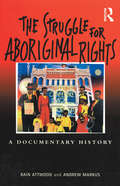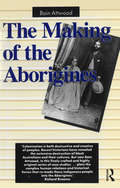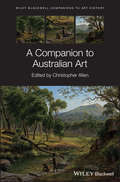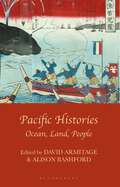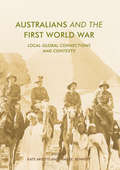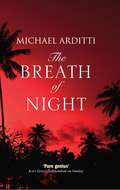- Table View
- List View
Empire and Environmental Anxiety: Health, Science, Art and Conservation in South Asia and Australasia, 1800-1920 (Palgrave Studies in World Environmental History)
by J. BeattieA new interpretation of imperialism and environmental change, and the anxieties imperialism generated through environmental transformation and interaction with unknown landscapes. Tying together South Asia and Australasia, this book demonstrates how environmental anxieties led to increasing state resource management, conservation, and urban reform.
The Holocaust and Australia: Refugees, Rejection, and Memory (Perspectives on the Holocaust)
by Paul R. BartropPaul R. Bartrop examines the formation and execution of Australian government policy towards European Jews during the Holocaust period, revealing that Australia did not have an established refugee policy (as opposed to an immigration policy) until late 1938. He shows that, following the Evian Conference of July 1938, Interior Minister John McEwen pledged a new policy of accepting 15,000 refugees (not specifically Jewish), but the bureaucracy cynically sought to restrict Jewish entry despite McEwen's lofty ambitions. Moreover, the book considers the (largely negative) popular attitudes toward Jewish immigrants in Australia, looking at how these views were manifested in the press and in letters to the Department of the Interior. The Holocaust and Australia grapples with how, when the Second World War broke out, questions of security were exploited as the means to further exclude Jewish refugees, a policy incongruous alongside government pronouncements condemning Nazi atrocities. The book also reflects on the double standard applied towards refugees who were Jewish and those who were not, as shown through the refusal of the government to accept 90% of Jewish applications before the war. During the war years this double standard continued, as Australia said it was not accepting foreign immigrants while taking in those it deemed to be acceptable for the war effort. Incorporating the voices of the Holocaust refugees themselves and placing the country's response in the wider contexts of both national and international history in the decades that have followed, Paul R. Bartrop provides a peerless Australian perspective on one of the most catastrophic episodes in world history.
The Holocaust and Australia: Refugees, Rejection, and Memory (Perspectives on the Holocaust)
by Paul R. BartropPaul R. Bartrop examines the formation and execution of Australian government policy towards European Jews during the Holocaust period, revealing that Australia did not have an established refugee policy (as opposed to an immigration policy) until late 1938. He shows that, following the Evian Conference of July 1938, Interior Minister John McEwen pledged a new policy of accepting 15,000 refugees (not specifically Jewish), but the bureaucracy cynically sought to restrict Jewish entry despite McEwen's lofty ambitions. Moreover, the book considers the (largely negative) popular attitudes toward Jewish immigrants in Australia, looking at how these views were manifested in the press and in letters to the Department of the Interior. The Holocaust and Australia grapples with how, when the Second World War broke out, questions of security were exploited as the means to further exclude Jewish refugees, a policy incongruous alongside government pronouncements condemning Nazi atrocities. The book also reflects on the double standard applied towards refugees who were Jewish and those who were not, as shown through the refusal of the government to accept 90% of Jewish applications before the war. During the war years this double standard continued, as Australia said it was not accepting foreign immigrants while taking in those it deemed to be acceptable for the war effort. Incorporating the voices of the Holocaust refugees themselves and placing the country's response in the wider contexts of both national and international history in the decades that have followed, Paul R. Bartrop provides a peerless Australian perspective on one of the most catastrophic episodes in world history.
Indians and the Antipodes: Networks, Boundaries, and Circulation
by Sekhar Bandyopadhyay Jane BuckinghamThe Indian diaspora in Australia and New Zealand represents a successful ethnic community making significant contributions to their host societies and economies. However, because of their small number—slightly more than half a million— they rarely find mention in the global literature on Indian diaspora. The present volume seeks to remedy this oversight. Charting the chequered 250-year-old history of both the ‘old’ and the ‘new’ diaspora in the antipodes, the chapters narrate the stories of labourers who journeyed under the pressure of colonial capital and post-war professional migrants who went in search of better opportunities. In the context of the ‘White Australia’ and ‘White New Zealand’ policies designed to stem the arrival of Asians in the early twentieth century, we read of the complex survival stratagems adopted by migrants to circumvent the stringent insular world view of the existing white settlers in these countries. Together with stories of the collective suffering and struggles of the diaspora, we are presented with stories of individual resilience, enterprise, and social mobility.
The Making and Remaking of Australasia: Mobility, Texts and ‘Southern Circulations’ (Empire’s Other Histories)
by Tony BallantyneThis book explores the emergence of 'Australasia' as a way of thinking about the culture and geography of this region. Although it is frequently understood to apply only to Australia and New Zealand, the concept has a longer and more complicated history. 'Australasia' emerged in the mid-18th century in both French and British writing as European empires extended their reach into Asia and the Pacific, and initially held strong links to the Asian continent. The book shows that interpretations and understandings of 'Australasia' shifted away from Asia in light of British imperial interests in the 19th century, and the concept was adapted by varying political agendas and cultural visions in order to reach into the Pacific or towards Antarctica. The Making and Remaking of Australasia offers a number of rich case studies which highlight how the idea itself was adapted and moulded by people and texts both in the southern hemisphere and the imperial metropole where a range of competing actors articulated divergent visions of this part of the British Empire. An important contribution to the cultural history of the British Empire, Australia, New Zealand and Pacific Studies, this collection shows how 'Australasia' has had multiple, often contrasting, meanings.
Behavioural Public Policy in Australia: How an Idea Became Practice (Public Administration and Public Policy)
by Sarah BallUsing rich ethnographic data and first-hand experience, Ball presents a detailed account of Australia’s attempts to incorporate behavioural insights into its public policy. Ball identifies three competing interpretations of behavioural public policy, and how these interpretations have influenced the use of this approach in practice. The first sees the process as an opportunity to introduce more rigorous evidence. The second interpretation focuses on increasing compliance, cost savings and cutting red tape. The last focuses on the opportunity to better involve citizens in policy design. These interpretations demonstrate different ‘solutions’ to a series of dilemmas that the Australian Public Service, and others, have confronted in the last 50 years, including growing politicisation, technocracy and a disconnect from the needs of citizens. Ball offers a detailed account of how these priorities have shaped how behavioural insights have been implemented in policy-making, as well as reflecting on the challenges facing policy work more broadly. An essential read for practitioners and scholars of policy-making, especially in Australia.
Behavioural Public Policy in Australia: How an Idea Became Practice (Public Administration and Public Policy)
by Sarah BallUsing rich ethnographic data and first-hand experience, Ball presents a detailed account of Australia’s attempts to incorporate behavioural insights into its public policy. Ball identifies three competing interpretations of behavioural public policy, and how these interpretations have influenced the use of this approach in practice. The first sees the process as an opportunity to introduce more rigorous evidence. The second interpretation focuses on increasing compliance, cost savings and cutting red tape. The last focuses on the opportunity to better involve citizens in policy design. These interpretations demonstrate different ‘solutions’ to a series of dilemmas that the Australian Public Service, and others, have confronted in the last 50 years, including growing politicisation, technocracy and a disconnect from the needs of citizens. Ball offers a detailed account of how these priorities have shaped how behavioural insights have been implemented in policy-making, as well as reflecting on the challenges facing policy work more broadly. An essential read for practitioners and scholars of policy-making, especially in Australia.
Badiou and His Interlocutors: Lectures, Interviews and Responses
by Alain Badiou A. J. Bartlett Justin ClemensThis is a unique collection presenting work by Alain Badiou and commentaries on his philosophical theories. It includes three lectures by Badiou, on contemporary politics, the infinite, cinema and theatre and two extensive interviews with Badiou – one concerning the state of the contemporary situation and one wide ranging interview on all facets of his work and engagements. It also includes six interventions on aspects of Badiou's work by established scholars in the field, addressing his concept of history, Lacan, Cinema, poetry, and feminism; and four original essays by young and established scholars in Australia and New Zealand addressing the key concerns of Badiou's 2015 visit to the Antipodal region and the work he presented there.With new material by Badiou previously unpublished in English this volume is a valuable overview of his recent thinking. Critical responses by distinguished and gifted Badiou scholars writing outside of the European context make this text essential reading for anyone interested in the development and contemporary reception of Badiou's thought.
Badiou and His Interlocutors: Lectures, Interviews and Responses
by Alain Badiou A. J. Bartlett Justin ClemensThis is a unique collection presenting work by Alain Badiou and commentaries on his philosophical theories. It includes three lectures by Badiou, on contemporary politics, the infinite, cinema and theatre and two extensive interviews with Badiou – one concerning the state of the contemporary situation and one wide ranging interview on all facets of his work and engagements. It also includes six interventions on aspects of Badiou's work by established scholars in the field, addressing his concept of history, Lacan, Cinema, poetry, and feminism; and four original essays by young and established scholars in Australia and New Zealand addressing the key concerns of Badiou's 2015 visit to the Antipodal region and the work he presented there.With new material by Badiou previously unpublished in English this volume is a valuable overview of his recent thinking. Critical responses by distinguished and gifted Badiou scholars writing outside of the European context make this text essential reading for anyone interested in the development and contemporary reception of Badiou's thought.
Mediating Memory: Tracing the Limits of Memoir (Routledge Interdisciplinary Perspectives on Literature)
by Bunty Avieson Fiona Giles Sue JosephThe argument has been made that memoir reflects and augments the narcissistic tendencies of our neo-liberal age. Mediating Memory: Tracing the Limits of Memoir challenges and dismantles that assumption. Focusing on the history, theory and practice of memoir writing, editors Bunty Avieson, Fiona Giles and Sue Joseph provide a thorough and cutting-edge examination of memoir through the lenses of ethics, practice and innovation. By investigating memoir across cultural boundaries, in its various guises, and tracing its limits, the editors convincingly demonstrate the plurality of ways in which memoir is helping us make sense of who we are, who we were and the influences that shape us along the way.
Still Here: Memoirs of Trauma, Illness and Loss (Routledge Interdisciplinary Perspectives on Literature)
by Bunty Avieson Fiona Giles Sue JosephStill Here: Memoirs of Trauma, Illness and Loss explores the history, ethics, and cross-cultural range of memoirs focusing on illness, death, loss, displacement, and other experiences of trauma. From Walt Whitman’s Civil War diaries to kitchen table survivor-to-survivor storytelling following Hurricane Katrina, from social media posts from a refugee detention centre, to poetry by exiles fleeing war zones, the collection investigates trauma memoir writing as healing, as documentation of suffering and disability, and as political activism. Editors Bunty Avieson, Fiona Giles and Sue Joseph have brought together this scholarly collection as a sequel to their earlier Mediating Memory (Routledge 2018), providing a closer look at the specific concerns of trauma memoir, including conflict and intergenerational trauma; the therapeutic potential and risks of trauma life writing; its ethical challenges; and trauma memoir giving voice to minority experiences.
Still Here: Memoirs of Trauma, Illness and Loss (Routledge Interdisciplinary Perspectives on Literature)
by Bunty Avieson Fiona Giles Sue JosephStill Here: Memoirs of Trauma, Illness and Loss explores the history, ethics, and cross-cultural range of memoirs focusing on illness, death, loss, displacement, and other experiences of trauma. From Walt Whitman’s Civil War diaries to kitchen table survivor-to-survivor storytelling following Hurricane Katrina, from social media posts from a refugee detention centre, to poetry by exiles fleeing war zones, the collection investigates trauma memoir writing as healing, as documentation of suffering and disability, and as political activism. Editors Bunty Avieson, Fiona Giles and Sue Joseph have brought together this scholarly collection as a sequel to their earlier Mediating Memory (Routledge 2018), providing a closer look at the specific concerns of trauma memoir, including conflict and intergenerational trauma; the therapeutic potential and risks of trauma life writing; its ethical challenges; and trauma memoir giving voice to minority experiences.
Arrernte Present, Arrernte Past: Invasion, Violence, and Imagination in Indigenous Central Australia
by Diane J. Austin-BroosThe Arrernte people of Central Australia first encountered Europeans in the 1860s as groups of explorers, pastoralists, missionaries, and laborers invaded their land. During that time the Arrernte were the subject of intense curiosity, and the earliest accounts of their lives, beliefs, and traditions were a seminal influence on European notions of the primitive. The first study to address the Arrernte’s contemporary situation, Arrernte Present, Arrernte Past also documents the immense sociocultural changes they have experienced over the past hundred years. Employing ethnographic and archival research, Diane Austin-Broos traces the history of the Arrernte as they have transitioned from a society of hunter-gatherers to members of the Hermannsburg Mission community to their present, marginalized position in the modern Australian economy. While she concludes that these wrenching structural shifts led to the violence that now marks Arrernte communities, she also brings to light the powerful acts of imagination that have sustained a continuing sense of Arrernte identity.
Arrernte Present, Arrernte Past: Invasion, Violence, and Imagination in Indigenous Central Australia (The\bush School Series In The Economics Of Public Policy)
by Diane J. Austin-BroosThe Arrernte people of Central Australia first encountered Europeans in the 1860s as groups of explorers, pastoralists, missionaries, and laborers invaded their land. During that time the Arrernte were the subject of intense curiosity, and the earliest accounts of their lives, beliefs, and traditions were a seminal influence on European notions of the primitive. The first study to address the Arrernte’s contemporary situation, Arrernte Present, Arrernte Past also documents the immense sociocultural changes they have experienced over the past hundred years. Employing ethnographic and archival research, Diane Austin-Broos traces the history of the Arrernte as they have transitioned from a society of hunter-gatherers to members of the Hermannsburg Mission community to their present, marginalized position in the modern Australian economy. While she concludes that these wrenching structural shifts led to the violence that now marks Arrernte communities, she also brings to light the powerful acts of imagination that have sustained a continuing sense of Arrernte identity.
Arrernte Present, Arrernte Past: Invasion, Violence, and Imagination in Indigenous Central Australia (The\bush School Series In The Economics Of Public Policy)
by Diane J. Austin-BroosThe Arrernte people of Central Australia first encountered Europeans in the 1860s as groups of explorers, pastoralists, missionaries, and laborers invaded their land. During that time the Arrernte were the subject of intense curiosity, and the earliest accounts of their lives, beliefs, and traditions were a seminal influence on European notions of the primitive. The first study to address the Arrernte’s contemporary situation, Arrernte Present, Arrernte Past also documents the immense sociocultural changes they have experienced over the past hundred years. Employing ethnographic and archival research, Diane Austin-Broos traces the history of the Arrernte as they have transitioned from a society of hunter-gatherers to members of the Hermannsburg Mission community to their present, marginalized position in the modern Australian economy. While she concludes that these wrenching structural shifts led to the violence that now marks Arrernte communities, she also brings to light the powerful acts of imagination that have sustained a continuing sense of Arrernte identity.
The Struggle for Aboriginal Rights: A documentary history
by Bain Attwood Andrew MarkusThe Struggle for Aboriginal Rights is the first book of its kind. Not only does it tell the history of the political struggle for Aboriginal rights in all parts of Australia; it does so almost entirely through a selection of historical documents created by the Aboriginal campaigners themselves, many of which have never been published. It presents Aboriginal perspectives of their dispossession and their long and continuing fight to overcome this. In charting the story of Aboriginal political activity from its beginnings on Flinders Island in the 1830s to the fight over native title today, this book aims to help Australians better understand both the continuities and the changes in Aboriginal politics over the last 150 years: in the leadership of the Aboriginal political struggle, the objectives of these campaigners for rights for Aborigines, their aspirations, the sources of their programmes for change, their methods of protest, and the outcomes of their protest. Through the words of Aboriginal activists, across 150 years, The Struggle for Aboriginal Rights charts the relationship between political involvement and Aboriginal identity.
The Making of the Aborigines
by Bain AttwoodBefore 1788, the peoples of this continent did not consider themselves 'Aboriginal'. They only became 'Aborigines' in the wake of the British invasion. In this startling and original study, Bain Attwood reveals how relationships between black Australians and European colonisers determined the hearts and minds of the indigenous peoples, making them anew as Aboriginals.In examining the period after the 'killing times', this young historian provides new perspectives on racial ideology, government policy, and the rule of law. In examining European domination, he unravels the patterns of associations which were woven between European and Aborigine, and shows the complex meanings and significance these relationships held for both groups.In this book, the dispossessed are not cast as merely passive victims; they appear as real characters, men and women who adapted to European colonisation in accordance with their own historical and cultural experience. Out of this exchange the colonised created a new consciousness and began to forge a common identity for themselves.A story of cultural change and continuity both poignant and disturbing in its telling, this important book is sure to provoke controversy about what it means to be Aboriginal.'This intelligent and impeccably researched book seeks to advance our understanding of the story of white/Aboriginal contact. It will be required reading for anyone working in the field.' - Henry Reynolds'Colonisation is both destructive and creative of peoples. Recent historians have revealed the extensive destruction of black Australians and their cultures. But now Bain Attwood, in this finely crafted and highly original series of case studies. plots the complex human relations and historical forces that re-made these indigenous people into the Aborigines.' - Richard Broome
The Making of the Aborigines
by Bain AttwoodBefore 1788, the peoples of this continent did not consider themselves 'Aboriginal'. They only became 'Aborigines' in the wake of the British invasion. In this startling and original study, Bain Attwood reveals how relationships between black Australians and European colonisers determined the hearts and minds of the indigenous peoples, making them anew as Aboriginals.In examining the period after the 'killing times', this young historian provides new perspectives on racial ideology, government policy, and the rule of law. In examining European domination, he unravels the patterns of associations which were woven between European and Aborigine, and shows the complex meanings and significance these relationships held for both groups.In this book, the dispossessed are not cast as merely passive victims; they appear as real characters, men and women who adapted to European colonisation in accordance with their own historical and cultural experience. Out of this exchange the colonised created a new consciousness and began to forge a common identity for themselves.A story of cultural change and continuity both poignant and disturbing in its telling, this important book is sure to provoke controversy about what it means to be Aboriginal.'This intelligent and impeccably researched book seeks to advance our understanding of the story of white/Aboriginal contact. It will be required reading for anyone working in the field.' - Henry Reynolds'Colonisation is both destructive and creative of peoples. Recent historians have revealed the extensive destruction of black Australians and their cultures. But now Bain Attwood, in this finely crafted and highly original series of case studies. plots the complex human relations and historical forces that re-made these indigenous people into the Aborigines.' - Richard Broome
A Companion to Australian Art (Blackwell Companions to Art History)
by Dana ArnoldAn accessible and balanced introduction to the history of Australian art from colonization to the present The Companion to Australian Art is a thorough introduction to the art produced in Australia beginning from the arrival of the First Fleet in 1788. Focusing on the colonial art tradition of Australia's European settlers, this volume presents a collection of clear, accessible, and well-focused essays by established art historians and emerging scholars alike. Engaging, jargon-free chapters provide fresh insights on various Australian artforms in different chronological, regional, and thematic contexts. The text provides a balanced and unbiased description of historical events to help readers encounter the art of Australia on their own terms and draw their own conclusions. The book begins by surveying the historiography of Australian art and exploring the history of art museums in Australia. The following chapters discuss artforms such as photography, sculpture, portraiture, and landscape painting, and examine the art traditions of the separate colonies up to Federation in 1901, and then the art tradition of the Commonwealth from the early nineteenth century to the present. This authoritative volume: Helps non-specialist readers understand and appreciate the art of Australia Covers 250 years of art movements in Australia, including Neo-classicism, Romanticism, Realism, Impressionism, and the various forms of Modernism Explores the way Australian art has been considered and exhibited since the beginning of colonization Discusses the state of contemporary art and how traditional Aboriginal art has adapted and changed over the last half-century Offers new perspectives on cultural and aesthetic debates both past and present The Companion to Australian Art is a valuable resource for both undergraduate and graduate students of the history of Australian artforms from colonization to postmodernism, and for general readers with an interest in the nation’s colonial art history.
A Companion to Australian Art (Blackwell Companions to Art History)
by Dana ArnoldA Companion to Australian Art A Companion to Australian Art is a thorough introduction to the art produced in Australia from the arrival of the First Fleet in 1788 to the early 21st century. Beginning with the colonial art made by Australia’s first European settlers, this volume presents a collection of clear and accessible essays by established art historians and emerging scholars alike. Engaging, clearly-written chapters provide fresh insights into the principal Australian art movements, considered from a variety of chronological, regional and thematic perspectives.The text seeks to provide a balanced account of historical events to help readers discover the art of Australia on their own terms and draw their own conclusions. The book begins by surveying the historiography of Australian art and exploring the history of art museums in Australia. The following chapters discuss art forms such as photography, sculpture, portraiture and landscape painting, examining the practice of art in the separate colonies before Federation, and in the Commonwealth from the early 20th century to the present day. This authoritative volume covers the last 250 years of art in Australia, including the Early Colonial, High Colonial and Federation periods as well as the successive Modernist styles of the 20th century, and considers how traditional Aboriginal art has adapted and changed over the last fifty years.The Companion to Australian Art is a valuable resource for both undergraduate and graduate students of the history of Australian artforms from colonization to postmodernism, and for general readers with an interest in the nation’s colonial art history.
Pacific Histories: Ocean, Land, People
by David Armitage Alison BashfordThe first comprehensive account to place the Pacific Islands, the Pacific Rim and the Pacific Ocean into the perspective of world history. A distinguished international team of historians provides a multidimensional account of the Pacific, its inhabitants and the lands within and around it over 50,000 years, with special attention to the peoples of Oceania. It providing chronological coverage along with analyses of themes such as the environment, migration and the economy; religion, law and science; race, gender and politics.
Australians and the First World War: Local-Global Connections and Contexts
by Kate Ariotti James E. BennettThis book contributes to the global turn in First World War studies by exploring Australians’ engagements with the conflict across varied boundaries and by situating Australian voices and perspectives within broader, more complex contexts. This diverse and multifaceted collection includes chapters on the composition and contribution of the Australian Imperial Force, the experiences of prisoners of war, nurses and Red Cross workers, the resonances of overseas events for Australians at home, and the cultural legacies of the war through remembrance and representation. The local-global framework provides a fresh lens through which to view Australian connections with the Great War, demonstrating that there is still much to be said about this cataclysmic event in modern history.
Australians and the First World War: Local-Global Connections and Contexts
by Kate Ariotti James E. BennettThis book contributes to the global turn in First World War studies by exploring Australians’ engagements with the conflict across varied boundaries and by situating Australian voices and perspectives within broader, more complex contexts. This diverse and multifaceted collection includes chapters on the composition and contribution of the Australian Imperial Force, the experiences of prisoners of war, nurses and Red Cross workers, the resonances of overseas events for Australians at home, and the cultural legacies of the war through remembrance and representation. The local-global framework provides a fresh lens through which to view Australian connections with the Great War, demonstrating that there is still much to be said about this cataclysmic event in modern history.
The Breath of Night
by Michael ArdittiPhilip Seward travels to the Philippines to investigate the case of a missionary priest imprisoned for murder, where he is drawn into a labyrinth of vice, violence, and corruption where nothing and nobody are what they seem.'Part Conrad, part Waugh, part Greene, and pure genius' Independent on Sunday'This is Arditti's most dazzling novel to date because of the scale of his ambition and his triumph in pulling it off' Peter Stanford, Daily TelegraphWhile working as a missionary priest in the Philippines during the Marcos dictatorship, Julian Tremayne championed the Communist rebels and found himself imprisoned for murder. Now, three decades later, following Julian's death, a cult develops around him, even calling for sainthood. When Philip Seward goes to investigate on behalf of Julian's family, he is drawn into a labyrinth of vice, violence, and corruption where nothing and nobody are what they seem. Enriched by a gallery of engaging characters ranging from priests to prostitutes, GIs to gangsters, and street children to Imelda Marcos, this outstanding novel is at once a gripping psychological thriller, a challenging moral mystery, and an unforgettable voyage into a dark and exotic landscape.
